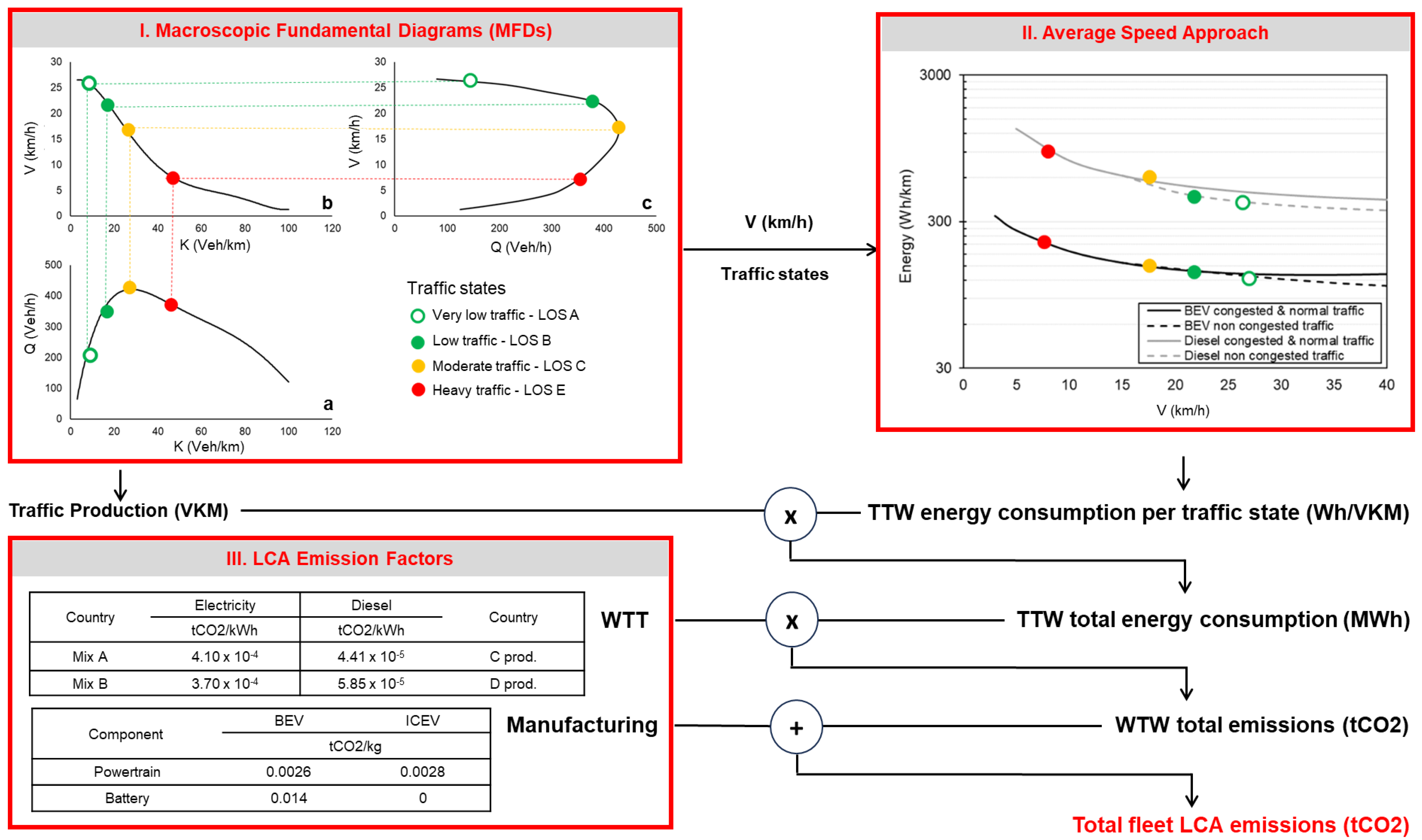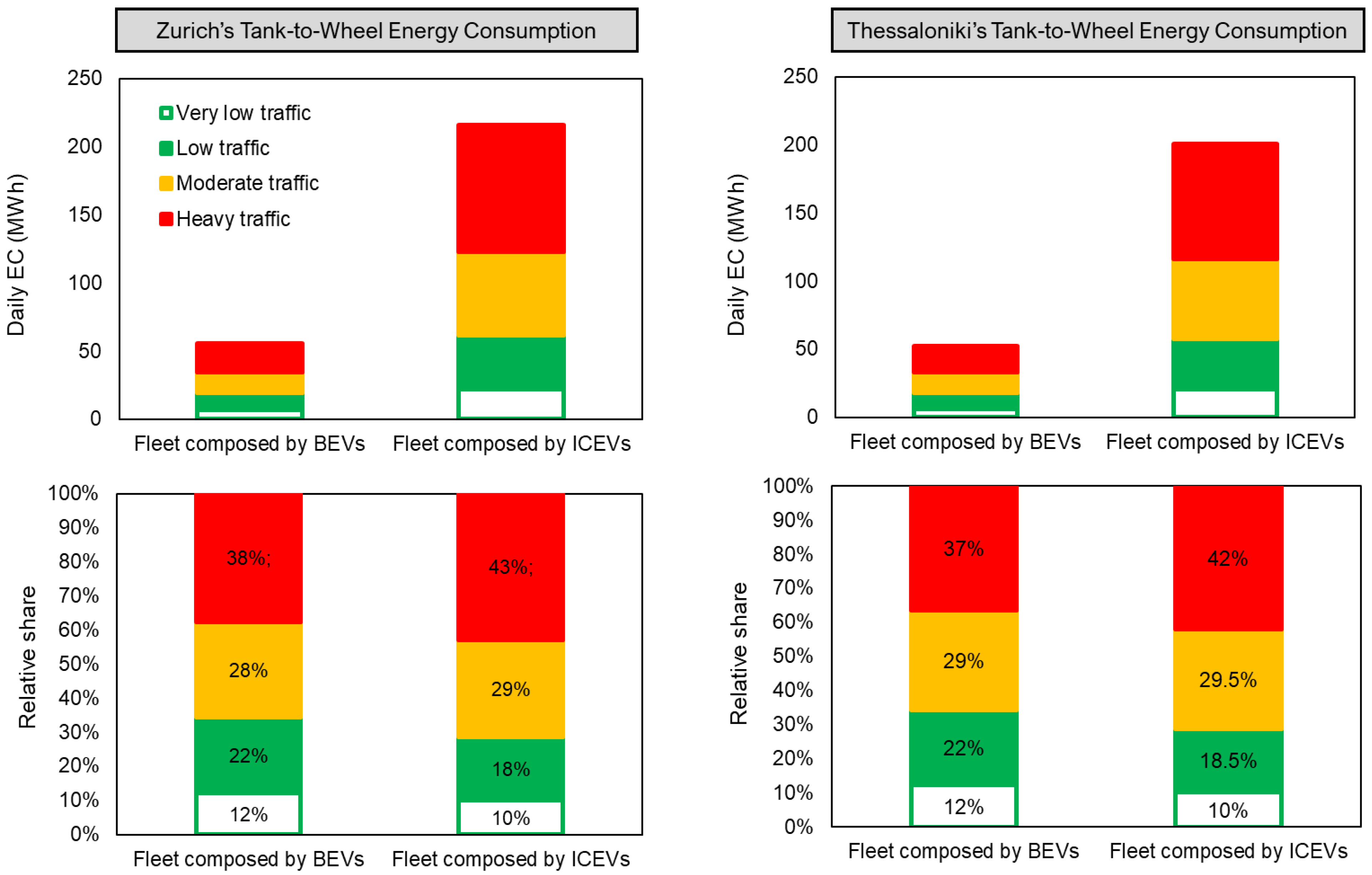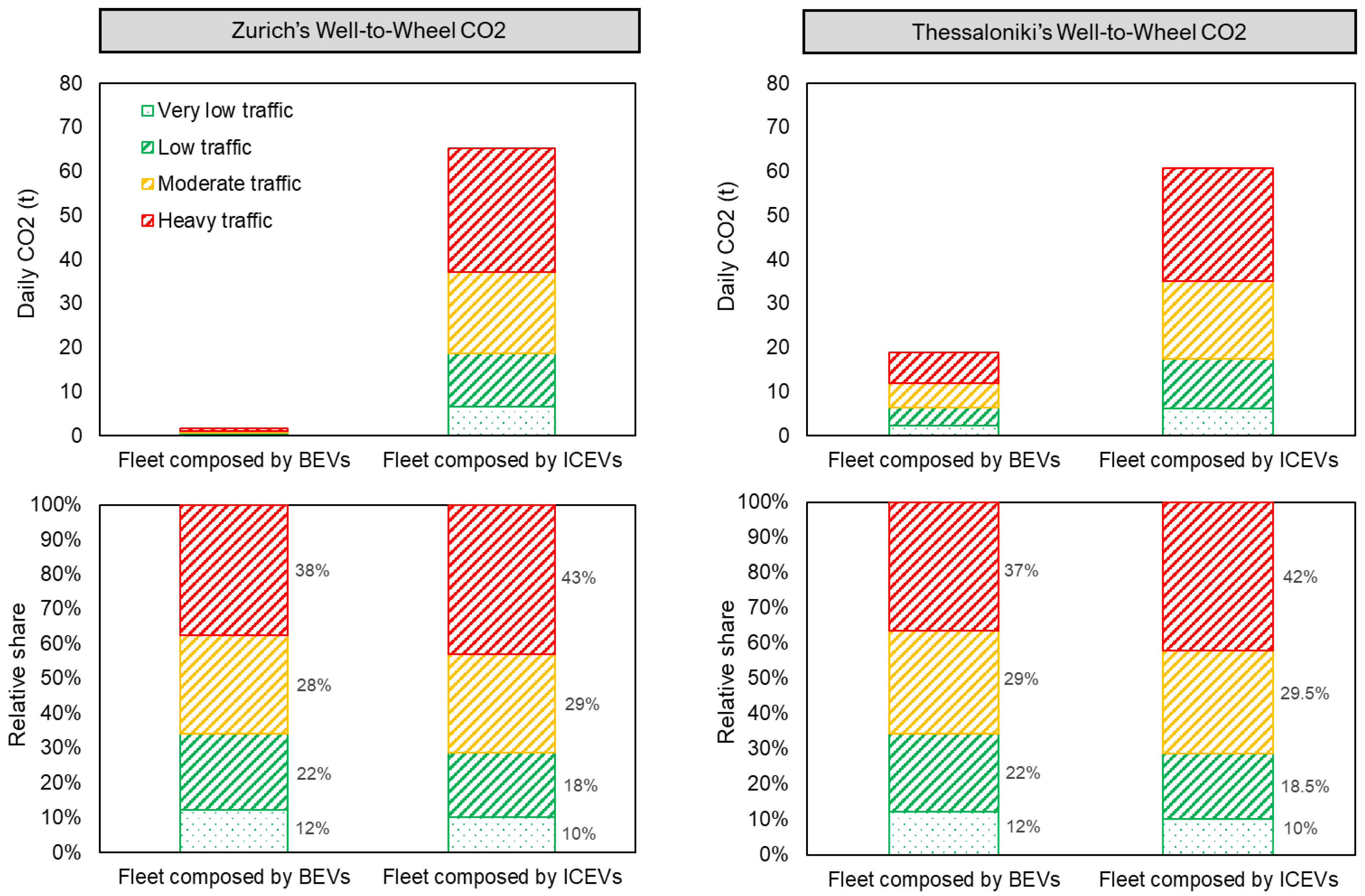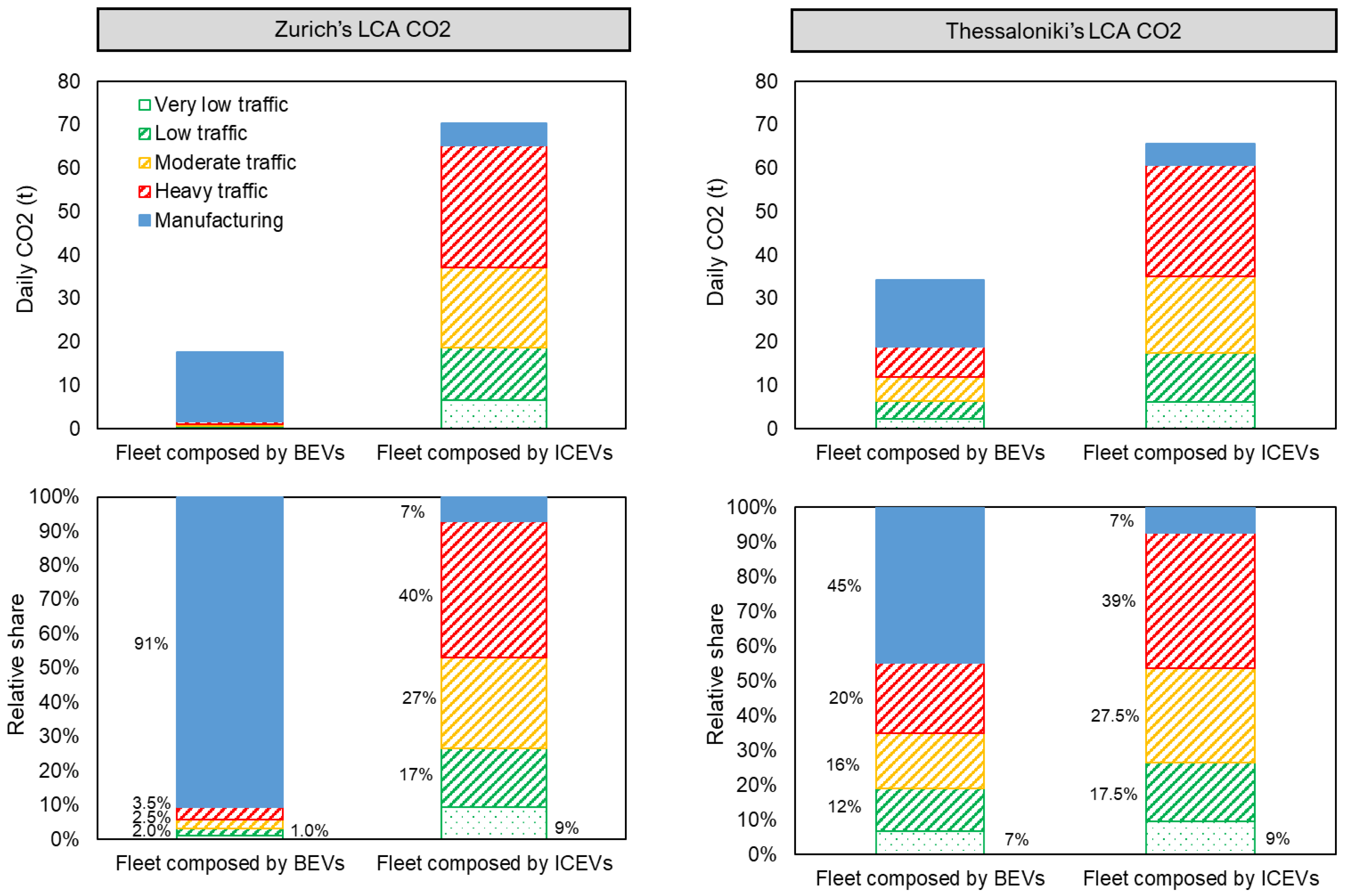An Efficient Concept to Integrate Traffic Activity Dynamics into Fleet LCAs
Abstract
1. Introduction
2. Materials and Methods
2.1. Fleet LCA Concept Overview
2.2. Integrated Methodology
2.2.1. Traffic Performance with MFDs
2.2.2. Tank-to-Wheel Energy Consumption/Emissions with the Average Speed Approach
2.2.3. Well-to-Tank, Manufacturing, and End-of-Life Impacts with Emission Factors
2.2.4. Overall Impacts
3. Results—Application Through Theoretical Case Studies
3.1. Scenario
3.2. Traffic Performance Evaluation
3.3. Energy Consumption/Emissions Performance Evaluation
3.3.1. Tank-to-Wheel Evaluation
3.3.2. Well-to-Wheel and LCA Evaluation
4. Conclusions
Author Contributions
Funding
Data Availability Statement
Acknowledgments
Conflicts of Interest
References
- Colvile, R.N.; Hutchinson, E.J.; Mindell, J.S.; Warren, R.F. The transport sector as a source of air pollution. Atmos. Environ. 2001, 35, 1537–1565. [Google Scholar] [CrossRef]
- Eggleston, H.S.; Buendia, L.; Miwa, K.; Ngara, T.; Tanabe, K. 2006 IPCC Guidelines for National Greenhouse Gas Inventories; Intergovernmental Panel on Climate Change: Geneva, Switzerland, 2006. [Google Scholar]
- EMEP/EEA. Air Pollutant Emission Inventory Guidebook—Technical Guidance to Prepare National Emission Inventories; European Environment Agency: Copenhagen, Denmark, 2019. [Google Scholar]
- Frey, H.C.; Rouphail, N.M.; Unal, A.; Colyar, J.D. Emissions Reduction Through Better Traffic Management: An Empirical Evaluation Based Upon On-Road Measurements (No. FHWA/NC/2002-001). 2001. Available online: https://trid.trb.org/View/661327 (accessed on 5 May 2025).
- Barth, M.; Boriboonsomsin, K. Real-world carbon dioxide impacts of traffic congestion. Transp. Res. Rec. 2008, 2058, 163–171. [Google Scholar] [CrossRef]
- Shaheen, S.A.; Lipman, T.E. Reducing greenhouse emissions and fuel consumption: Sustainable approaches for surface transportation. IATSS Res. 2007, 31, 6–20. [Google Scholar] [CrossRef]
- Klunder, G.A.; Malone, K.; Mak, J.; Wilmink, I.R.; Schirokoff, A.; Sihvola, N.; Holmén, C.; Berger, A.; de Lange, R.; Roeterdink, W.; et al. Impact of Information and Communication Technologies on Energy Efficiency in Road Transport: Final Report. Commission of European Communities (CEC). EU Publications. 2009. Available online: https://publications.europa.eu/en/publication-detail/-/publication/6b4f8023-5a8a-4b97-8d29-82924574cc97/language-en (accessed on 16 June 2025).
- Samaras, C.; Tsokolis, D.; Toffolo, S.; Magra, G.; Ntziachristos, L.; Samaras, Z. Enhancing average speed emission models to account for congestion impacts in traffic network link-based simulations. Transp. Res. Part D Transp. Environ. 2019, 75, 197–210. [Google Scholar] [CrossRef]
- Qi, X.; Wu, G.; Boriboonsomsin, K.; Barth, M.J. Data-driven decomposition analysis and estimation of link-level electric vehicle energy consumption under real-world traffic conditions. Transp. Res. Part D Transp. Environ. 2018, 64, 36–52. [Google Scholar] [CrossRef]
- Fiori, C.; Arcidiacono, V.; Fontaras, G.; Makridis, M.; Mattas, K.; Marzano, V.; Ciuffo, B. The effect of electrified mobility on the relationship between traffic conditions and energy consumption. Transp. Res. Part D Transp. Environ. 2019, 67, 275–290. [Google Scholar] [CrossRef]
- Helmers, E.; Marx, P. Electric cars: Technical characteristics and environmental impacts. Environ. Sci. Eur. 2012, 24, 14. [Google Scholar] [CrossRef]
- Smit, R.; Kennedy, D.W. Greenhouse Gas Emissions Performance of Electric and Fossil-Fueled Passenger Vehicles with Uncertainty Estimates Using a Probabilistic Life-Cycle Assessment. Sustainability 2022, 14, 3444. [Google Scholar] [CrossRef]
- Koroma, M.S.; Costa, D.; Philippot, M.; Cardellini, G.; Hosen, M.S.; Coosemans, T.; Messagie, M. Life cycle assessment of battery electric vehicles: Implications of future electricity mix and different battery end-of-life management. Sci. Total Environ. 2022, 831, 154859. [Google Scholar] [CrossRef] [PubMed]
- Mamarikas, S.; Doulgeris, S.; Samaras, Z.; Ntziachristos, L. Traffic impacts on energy consumption of electric and conventional vehicles. Transp. Res. Part D Transp. Environ. 2022, 105, 103231. [Google Scholar]
- Ilgin, M.A.; Gupta, S.M. Environmentally conscious manufacturing and product recovery (ECMPRO): A review of the state of the art. J. Environ. Manag. 2010, 91, 563–591. [Google Scholar] [CrossRef]
- Hawkins, T.R.; Singh, B.; Majeau-Bettez, G.; Strømman, A.H. Comparative environmental life cycle assessment of conventional and electric vehicles. J. Ind. Ecol. 2013, 17, 53–64. [Google Scholar] [CrossRef]
- De Souza, L.L.P.; Lora, E.E.S.; Palacio, J.C.E.; Rocha, M.H.; Renó, M.L.G.; Venturini, O.J. Comparative environmental life cycle assessment of conventional vehicles with different fuel options, plug-in hybrid and electric vehicles for a sustainable transportation system in Brazil. J. Clean. Prod. 2018, 203, 444–468. [Google Scholar] [CrossRef]
- Hill, N.; Amaral, S.; Morgan-Price, S.; Nokes, T.; Bates, J.; Helms, H.; Ziem-Milojevic, S. Determining the Environmental Impacts of Conventional and Alternatively Fuelled Vehicles Through LCA: FINAL Report; Publications Office of the European Union: Luxembourg, 2020. [Google Scholar]
- Bieker, G. A Global Comparison of the Life-Cycle Greenhouse Gas Emissions of Combustion Engine and Electric Passenger Cars; International Council on Clean Transportation (ICCT): Washington, DC, USA, 2021. [Google Scholar]
- García, A.; Monsalve-Serrano, J.; Martinez-Boggio, S.; Alcaide, R.S. Carbon footprint of battery electric vehicles considering average and marginal electricity mix. Energy 2023, 268, 126691. [Google Scholar] [CrossRef]
- Pavlovic, J.; Fontaras, G.; Ktistakis, M.; Anagnostopoulos, K.; Komnos, D.; Ciuffo, B.; Valverde, V. Understanding the origins and variability of the fuel consumption gap: Lessons learned from laboratory tests and a real-driving campaign. Environ. Sci. Eur. 2020, 32, 53. [Google Scholar] [CrossRef]
- Field, F.; Kirchain, R.; Clark, J. Life-cycle assessment and temporal distributions of emissions: Developing a fleet-based analysis. J. Ind. Ecol. 2000, 4, 71–91. [Google Scholar] [CrossRef]
- Garcia, R.; Freire, F. A review of fleet-based life-cycle approaches focusing on energy and environmental impacts of vehicles. Renew. Sustain. Energy Rev. 2017, 79, 935–945. [Google Scholar]
- Shui, B.; Luo, X.; Huang, G. Greenhouse gas emissions benefits of the lightweight vehicle fleet in China: A dynamic fleet perspective. Resour. Conserv. Recycl. 2024, 205, 107544. [Google Scholar] [CrossRef]
- Davies, B.; Llamas-Orozco, J.A.; Meng, F.; Posen, I.D.; MacLean, H.L.; Abdul-Manan, A.F.; McKechnie, J. Future material demand and greenhouse gas emissions implications for electrification of the UK light-duty vehicle fleet. RSC Sustain. 2024, 2, 2275–2288. [Google Scholar] [CrossRef]
- Patella, S.M.; Scrucca, F.; Asdrubali, F.; Carrese, S. Traffic simulation-based approach for a cradle-to-grave greenhouse gases emission model. Sustainability 2019, 11, 4328. [Google Scholar]
- Patella, S.M.; Scrucca, F.; Asdrubali, F.; Carrese, S. Carbon Footprint of autonomous vehicles at the urban mobility system level: A traffic simulation-based approach. Transp. Res. Part D Transp. Environ. 2019, 74, 189–200. [Google Scholar] [CrossRef]
- Göhlich, D.; Nagel, K.; Syré, A.M.; Grahle, A.; Martins-Turner, K.; Ewert, R.; Jefferies, D. Integrated approach for the assessment of strategies for the decarbonization of urban traffic. Sustainability 2001, 13, 839. [Google Scholar] [CrossRef]
- Barmpounakis, E.; Montesinos-Ferrer, M.; Gonzales, E.J.; Geroliminis, N. Empirical investigation of the emission-macroscopic fundamental diagram. Transp. Res. Part D Transp. Environ. 2021, 101, 103090. [Google Scholar] [CrossRef]
- Mamarikas, S.; Ntziachristos, L. Expected changes in the energy performance of traffic flows as penetrated by electrified vehicles. In Proceedings of the Transport Research Arena Conference Published by Transportation Research Procedia 2022, Transport Research Arena, Lisbon, Portugal, 14–17 November 2022; Volume 72, pp. 2355–2361. [Google Scholar]
- Batista, S.F.A.; Tilg, G.; Menéndez, M. Exploring the potential of aggregated traffic models for estimating network-wide emissions. Transp. Res. Part D Transp. Environ. 2022, 109, 103354. [Google Scholar] [CrossRef]
- Wang, Y.; Lv, C.; Nie, Q.; Liu, H. Analyzing the Impact of Road Accidents on Carbon Dioxide Emissions in Freeway Traffic: A Simulation and Statistical Modeling Approach. Sustainability 2024, 16, 2168. [Google Scholar] [CrossRef]
- Cifuentes, F.; González, C.M.; Trejos, E.M.; López, L.D.; Sandoval, F.J.; Cuellar, O.A.; Aristizábal, B.H. Comparison of top-down and bottom-up road transport emissions through high-resolution air quality modeling in a city of complex orography. Atmosphere 2021, 12, 1372. [Google Scholar] [CrossRef]
- Yang, Z.; Zhang, Q.; Chang, W.; Xiao, P.; Li, M. EGFormer: An enhanced transformer model with efficient attention mechanism for traffic flow forecasting. Vehicles 2024, 6, 120–139. [Google Scholar] [CrossRef]
- Stamos, I.; Maria, J.; Grau, S.; Mitsakis, E.; Mamarikas, S. Macroscopic fundamental diagrams: Simulation findings for Thessaloniki’s road network. Int. J. Traffic Transp. Eng. 2015, 5, 225–237. [Google Scholar] [CrossRef][Green Version]
- Wang, M.; Elgowainy, A.; Lee, U.; Baek, K.H.; Balchandani, S.; Benavides, P.T.; Zhang, J. Summary of Expansions and Updates in R&D GREET (No. ANL/ESIA-23/10); Argonne National Laboratory (ANL): Argonne, IL, USA, 2023. [Google Scholar][Green Version]
- Geroliminis, N.; Daganzo, C.F. Existence of urban-scale macroscopic fundamental diagrams: Some experimental findings. Transp. Res. Part B Methodol. 2008, 42, 759–770. [Google Scholar] [CrossRef]
- Ntziachristos, L.; Gkatzoflias, D.; Kouridis, C.; Samaras, Z. COPERT: A European road transport emission inventory model. In Information Technologies in Environmental Engineering, Proceedings of the 4th International ICSC Symposium, Thessaloniki, Greece, 28–29 May 2009; Springer: Berlin/Heidelberg, Germany; pp. 491–504.
- Ntziachristos, L.; Samaras, Z. Speed-dependent representative emission factors for catalyst passenger cars and influencing parameters. Atmos. Environ. 2000, 34, 4611–4619. [Google Scholar] [CrossRef]
- Loder, A.; Ambühl, L.; Menendez, M.; Axhausen, K.W. Understanding traffic capacity of urban networks. Sci. Rep. 2019, 9, 16283. [Google Scholar] [CrossRef] [PubMed]
- Landman, R.; Hoogendoorn, S.; Westerman, M.; Hoogendoorn-Lanser, S.; Van Kooten, J. Design and implementation of integrated network management in the Netherlands. In Proceedings of the 89th Annual Meeting of the Transportation Research Board, Washington, DC, USA, 10–14 January 2010. [Google Scholar]





| Traffic State | Variables | Zurich | Thessaloniki |
|---|---|---|---|
| Very Low Traffic | Condition | Free Flow | Free Flow |
| Speed | 27.5 km/h | 28.5 km/h | |
| Production | 9000 VKM | 8555 VKM | |
| Low Traffic | Condition | Non-Congested | Non-Congested |
| Speed | 22.9 km/h | 23.8 km/h | |
| Production | 15,000 VKM | 14,280 VKM | |
| Moderate Traffic | Condition | Normal | Normal |
| Speed | 15.4 km/h | 16.7 km/h | |
| Production | 16,800 VKM | 16,749 VKM | |
| Heavy Traffic | Condition | Congested | Congested |
| Speed | 7.2 km/h | 7.1 km/h | |
| Production | 15,800 VKM | 14,282 VKM |
| Traffic Performance | Energy Consumption Factors (Wh/km) | ||||
|---|---|---|---|---|---|
| Zurich | Thessaloniki | ||||
| Traffic State | Condition | Fleet Composed of BEVs | Fleet Composed of ICEVs | Fleet Composed of BEVs | Fleet Composed of ICEVs |
| Very Low Traffic | Free Flow | 126.4 | 404.3 | 124.5 | 398.6 |
| Low Traffic | Non-Congested | 136.1 | 441.2 | 134.1 | 432.6 |
| Moderate Traffic | Normal | 156.1 | 610.8 | 151.0 | 585.4 |
| Heavy Traffic | Congested | 220.9 | 976.2 | 222.4 | 986.7 |
| Energy Sources | Share in Switzerland | Share in Greece | CO2 LCA Factors Switzerland (t/Wh) | CO2 LCA Factors Greece (t/Wh) |
|---|---|---|---|---|
| Coal | - | 14% | - | 1.00 × 10−6 |
| Natural Gas | 6% | 45% | 4.67 × 10−7 | 4.67 × 10−7 |
| Hydro Power | 61% | 9% | 0 | 0 |
| Solar Energy | 4% | 12% | 0 | 0 |
| Wind Energy | - | 21% | - | 0 |
| Nuclear | 29% | - | 5.54 × 10−9 | - |
| Sum for Electricity | 100% | 100% | 2.82 × 10−8 | 3.45 × 10−7 |
| Automotive Diesel | 100% | 100% | 4.42 × 10−8 | 4.42 × 10−8 |
| Vehicle Components | BEVs Masses (kg) | ICEVs Masses (kg) | CO2 LCA Factors BEVs (t/kg) | CO2 LCA Factors ICEVs (t/kg) |
|---|---|---|---|---|
| Powertrain | 240 | 400 | 0.0026 | 0.0028 |
| Vehicle Body-Chassis | 900 | 903 | 0.0025 | 0.0025 |
| Battery | 300 | 0 | 0.014 | 0 |
| Assembly | - | - | 0.001 | 0.001 |
| Total | 1440 | 1300 | - | - |
Disclaimer/Publisher’s Note: The statements, opinions and data contained in all publications are solely those of the individual author(s) and contributor(s) and not of MDPI and/or the editor(s). MDPI and/or the editor(s) disclaim responsibility for any injury to people or property resulting from any ideas, methods, instructions or products referred to in the content. |
© 2025 by the authors. Licensee MDPI, Basel, Switzerland. This article is an open access article distributed under the terms and conditions of the Creative Commons Attribution (CC BY) license (https://creativecommons.org/licenses/by/4.0/).
Share and Cite
Mamarikas, S.; Samaras, Z.; Ntziachristos, L. An Efficient Concept to Integrate Traffic Activity Dynamics into Fleet LCAs. Energies 2025, 18, 5075. https://doi.org/10.3390/en18195075
Mamarikas S, Samaras Z, Ntziachristos L. An Efficient Concept to Integrate Traffic Activity Dynamics into Fleet LCAs. Energies. 2025; 18(19):5075. https://doi.org/10.3390/en18195075
Chicago/Turabian StyleMamarikas, Sokratis, Zissis Samaras, and Leonidas Ntziachristos. 2025. "An Efficient Concept to Integrate Traffic Activity Dynamics into Fleet LCAs" Energies 18, no. 19: 5075. https://doi.org/10.3390/en18195075
APA StyleMamarikas, S., Samaras, Z., & Ntziachristos, L. (2025). An Efficient Concept to Integrate Traffic Activity Dynamics into Fleet LCAs. Energies, 18(19), 5075. https://doi.org/10.3390/en18195075








